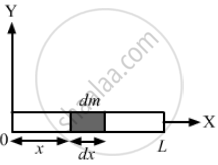Advertisements
Advertisements
प्रश्न
A rod of length L is placed along the X-axis between x = 0 and x = L. The linear density (mass/length) ρ of the rod varies with the distance x from the origin as ρ = a + bx. (a) Find the SI units of a and b. (b) Find the mass of the rod in terms of a, b and L.
उत्तर
ρ = mass/length = a + bx
So, the SI unit of ρ is kg/m.
(a)
SI unit of a = kg/m
SI unit of b = kg/m2
(From the principle of homogeneity of dimensions)
(b) Let us consider a small element of length dx at a distance x from the origin as shown in the figure given below:
dm = mass of the element
= ρdx
= (a + dx) dx
∴ Mass of the rod = ∫ dm
\[= \int_0^L \left( a + bx \right) dx\]
\[ = \left[ ax + \frac{b x^2}{2} \right]_0^L \]
\[ = aL + \frac{b L^2}{2}\]
APPEARS IN
संबंधित प्रश्न
Though India now has a large base in science and technology, which is fast expanding, it is still a long way from realizing its potential of becoming a world leader in science. Name some important factors, which in your view have hindered the advancement of science in India.
It is often said that the world is witnessing now a second industrial revolution, which will transform the society as radically as did the first. List some key contemporary areas of science and technology, which are responsible for this revolution.
Attempt to formulate your ‘moral’ views on the practice of science. Imagine yourself stumbling upon a discovery, which has great academic interest but is certain to have nothing but dangerous consequences for the human society. How, if at all, will you resolve your dilemma?
Though the law gives women equal status in India, many people hold unscientific views on a woman’s innate nature, capacity and intelligence; and in practice give them a secondary status and role. Demolish this view using scientific arguments, and by quoting examples of great women in science and other spheres; and persuade yourself and others that, given equal opportunity, women are on par with men.
The metre is defined as the distance travelled by light in `1/(299,792,458)` second. Why didn't people choose some easier number such as `1/(300,000,000)` second? Why not 1 second?
Suppose you are told that the linear size of everything in the universe has been doubled overnight. Can you test this statement by measuring sizes with a metre stick? Can you test it by using the fact that the speed of light is a universal constant and has not changed? What will happen if all the clocks in the universe also start running at half the speed?
Suggest a way to measure the distance between the sun and the moon.
Find the dimensions of electric dipole moment p .
The defining equations are p = q.d and M = IA;
where d is distance, A is area, q is charge and I is current.
Find the dimensions of magnetic dipole moment M.
The defining equations are p = q.d and M = IA;
where d is distance, A is area, q is charge and I is current.
Express the power of a 100 watt bulb in CGS unit.
The kinetic energy K of a rotating body depends on its moment of inertia I and its angular speedω. Assuming the relation to be \[k = KI^0w^B\] where k is a dimensionless constant, find a and b. Moment of inertia of a sphere about its diameter is \[\frac{2}{5}M r^2\]
The force on a charged particle due to electric and magnetic fields is given by \[\vec{F} = q \vec{E} + q \vec{\nu} \times \vec{B}\].
Suppose \[\vec{E}\] is along the X-axis and \[\vec{B}\] along the Y-axis. In what direction and with what minimum speed ν should a positively charged particle be sent so that the net force on it is zero?
Find the area bounded under the curve y = 3x2 + 6x + 7 and the X-axis with the ordinates at x = 5 and x = 10.
A metre scale is graduated at every millimetre. How many significant digits will be there in a length measurement with this scale?
